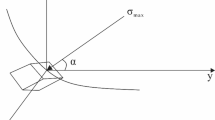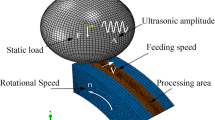Abstract
The formation mechanism of residual stress field (RSF) and the coupling mechanisms of RSFs after single-pass ultrasonic surface rolling process (USRP) are revealed. Based on simulation, the transient evolution and steady distribution of compressive RSF are analyzed, and the influences of process parameters (i.e., the movement distance of the ball in a single period L, ball radius R, static force F and ultrasonic amplitude A) on residual stress (RS) after single-pass USRP are investigated. The results show that the plastic strain, which is induced by the extrusion of the target surface with the ball applying static force and ultrasonic vibration, causes compressive RS layer mainly. A new RSF will be induced simultaneously when the ball vibrates for a period, then the RSF induced by each period couples with several adjacent RSFs, and a compressive RS layer forms on the target surface finally. Furthermore, the surface compressive RS, the depth of maximum compressive RS and the depth of compressive RS layer increase effectively with the increase in F. Decreasing R can increase the surface compressive RS while decrease the depth of compressive RS layer slightly. Increasing A can increase the depth of compressive RS layer obviously when F is small, while has less influence on compressive RSF when F is large. For a relatively small L, the surface RS is compressive and achieves a uniform distribution.













Similar content being viewed by others
References
Wang H B, Song G L and Tang G Y, Surf Coat Technol 282 (2015) 149.
Liu Y, Zhao X and Wang D, Mater Sci Technol 30 (2014) 627.
Li G, Qu S G, **e M X and Li X Q, Surf Coat Technol 316 (2017) 75.
Li G, Qu S G, Guan S and Wang F W, Surf Coat Technol 379 (2019) 124971.
Zhang H J, Zhao X H, Xu D S, Liu Y, Qiu X M, Trans Indian Inst Met 73 (2020) 1951.
Tan L, Zhang D H, Yao C F and Ren J X, J Mater Eng Perform 28 (2019) 6736.
Xu X C, Liu D X, Zhang X H, Liu C S, Liu D and Zhang W C, Int J Fatigue 125 (2019) 237.
Liu C S, Liu D X, Zhang X H, He G Y, Xu X C, Ao N, Ma A M and Liu D, Surf Coat Technol 370 (2019) 24.
Khan M K, Fitzpatrick M E, Wang Q Y, Pyoun Y S and Amanov A, Fatigue Fract Eng Mater Struct 41 (2018) 844.
Zhao Y C and Wen C B, J Mech Strength 39 (2017) 875.
Zhang M, Liu Z H, Deng J, Yang M J, Dai Q L and Zhang T Z, Appl Math Model 76 (2019) 800.
Zhang M, Deng J, Liu Z H and Zhou Y, Int J Mech Sci 163 (2019) 105144.
Jiao F, Lan S L, Zhao B and Wang Y, J Manuf Process 50 (2020) 573.
Jiao F, Lan S L, Wang Y and Zhao B, Surf Technol 49 (2020) 334.
Wang F, Men X H, Liu Y J and Fu X L, Simul Model Pract Theory 104 (2020) 102121.
He Z S, Zhao S S, Li C, Li D L, Zhang Y X, Fu T and Yu H X, Mach Sci Technol 24 (2020) 592.
He Z S, Li C, Zhao S S, Cui B B, Li D L, Yu H X, Chen L and Fu T, Metals 9 (2019) 936.
He Z S, Yu H X, Zhao S S, **ng J Q, Li D L, Li C, Chen L and Wang S, Int J Adv Manuf Technol 107 (2020) 3833.
He Z S, Cui B B, Zhao S S, Liu Z H, Yu J L, Li C, Yu H Y and Chen L, Proc IMechE Part L J Mater Des Appl 235 (2021) 777.
Li F Q and Zhao B, Surf Technol 48 (2019) 34.
Acknowledgements
This research was funded by the National Natural Science Foundation of China (51305408).
Author information
Authors and Affiliations
Corresponding author
Additional information
Publisher's Note
Springer Nature remains neutral with regard to jurisdictional claims in published maps and institutional affiliations.
Rights and permissions
About this article
Cite this article
He, Z., Yu, J., Cui, B. et al. Finite Element Analysis of Residual Stress Induced by Single-Pass Ultrasonic Surface Rolling Process. Trans Indian Inst Met 75, 1113–1123 (2022). https://doi.org/10.1007/s12666-021-02508-y
Received:
Accepted:
Published:
Issue Date:
DOI: https://doi.org/10.1007/s12666-021-02508-y




